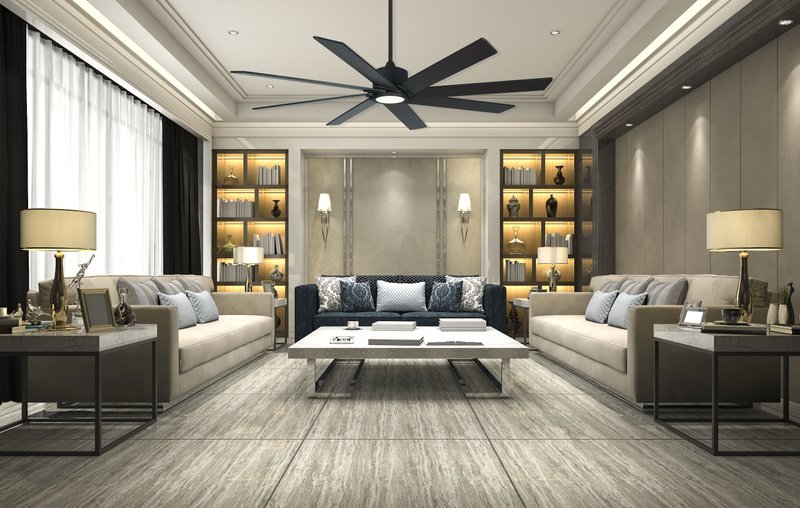"Don't look up!" I say to my husband, who, naturally, immediately zooms in on the outdoor ceiling fan precariously swinging from its rod like Tarzan, threatening to fall and decapitate us.
Wouldn't that be a fitting end? "Home columnist beheaded by her own ceiling fan!"
While I duck for cover, he calmly turns the fan off. "Time for a new fan," he says.
"We can't just fix it?"
"This fan is a piece of (cannot print)."
Frankly, until now, I'd never paid much attention to our ceiling fans indoors or out. They were givens. They came along with the house like doors and sinks. But now that decapitation was imminent, I'm noticing that the two, once-white outdoor fans had become rickety and yellow with age.
Next minute, my husband is on his laptop shopping for ceiling fans. Now we're in real trouble. He is out of his depth.
"Look at this one," he points to one with oversized palm fronds as blades.
"Uh, no, this isn't a Tommy Bahama store," I say.
"Oh, this one is cool!"
"It looks like a helicopter propeller."
"Well, what do you want?"
"A fan that doesn't say look at me, like we have now but newer."
"I want one you notice." He keeps scrolling.
"Noticeable fans are like women who wear red shoes."
"I don't want boring."
"You only wear red shoes when you don't want someone to look at your face."
"Well, I want a change."
To nip this fast, I call Darby Serra, the national sales director for Dan's Fan City, where he has worked for 30 years. The company sells fans online and through 50 stores in a handful of states.
"Many people don't appreciate the comfort and cost savings ceiling fans provide," said Serra, sounding well-scripted. "By evening out the temperature in a room, ceiling fans make air conditioners work less."
Excited about his subject, he continues, "Fans blow air down into a room like a cone, pushing the air at the base of the cone up the wall and back into the fan, to circulate."
"That's enough math for one day," I interrupt, because what I really want to talk about is how to pick a fan before my husband hits the buy-now button. Happy to oblige, Serra offered the following fan-picking tips:
Style: Fans come in dozens of styles: rustic, traditional, tropical, industrial, modern and more. Many are beautiful and would be wrong for your house. Consider your home's architecture, and look for a fan that suits it.
Size: The biggest mistake homeowners make is putting in a fan that's too small, which looks wrong and doesn't work. In rooms between 10-by-10 feet and 16-by-16 feet, you want no smaller than a 52-inch fan. In larger rooms go bigger.
Height: Rod length from ceiling also matters. On eight-foot ceilings, fan blades need 8 inches between the blades and ceiling for proper circulation. On higher ceilings, fan blades should sit between eight and 11 feet from the floor.
Color: Ask if you want a fan you notice or one that blends. "You don't get tired of white," Serra said. "It goes up, does its job and matches the ceiling." Usually, designers don't want a fan to upstage the decor, or the view out your window. But, if you do want a statement fan, choose a color and style that ties into the decor, or the hardware. Overall, Serra said, 60% of the indoor fans his company sells are white. If a designer is picking, that number jumps to 80%. The rest are mostly tan, brown, silver or black. Outside the reverse is true; 60% of outdoor fans are dark; only 40% are white. Dark finishes, mostly oil-rubbed bronze, are more popular outdoors because they don't show dirt, so look good for years.
Control: Wall switches now come with fan speed adjusters that work to power fans on and off and control their speed, eliminating the not-always-convenient chain and easy-to-lose remote.
Run them: Keeping fans running will extend their life, says Serra, who runs his 24/7, which he says costs only $1 a month. A fan can last 50 years or more.
The spin: Most fans have a switch that reverses their direction. In warm weather when the air conditioning is on, ceiling fans should move counterclockwise. In cool weather when the heat is on, they should rotate clockwise. I always found the opposite to be true until Serra straightened me out. I'd been determining the clock-face direction by looking up at the fan. The orientation should be as if you're looking down on it from the ceiling. (I'm sorry, but who does that?) So, yes, counterclockwise in warm weather, and clockwise in cold weather — if you're lying on the ceiling.
Cost: Fans range from $99 to $1000. The average homeowner spends $350 to $400 on a fan, plus installation.
Indoor vs outdoor: Any outdoor fan will work inside, but not vice versa. Outdoor fans are designed to resist moisture and rust, and are rated to use in wet locations. Outdoor fans will also have weather-resistant blades and stronger finishes.
After talking with Serra, I visited a Dan's Fan City store near me. Though I went in pretty set on getting two plain white fans to blend with the ceiling and to replace the old, wobbly yellowed ones, I worked with the manager to custom build two fans with oil-rubbed-bronze bases and brown, wood-grain blades, which made my husband — and me — happy. "I just wanted a change," he said.
Syndicated columnist Marni Jameson is the author of five home and lifestyle books.
HomeStyle on 05/30/2020
